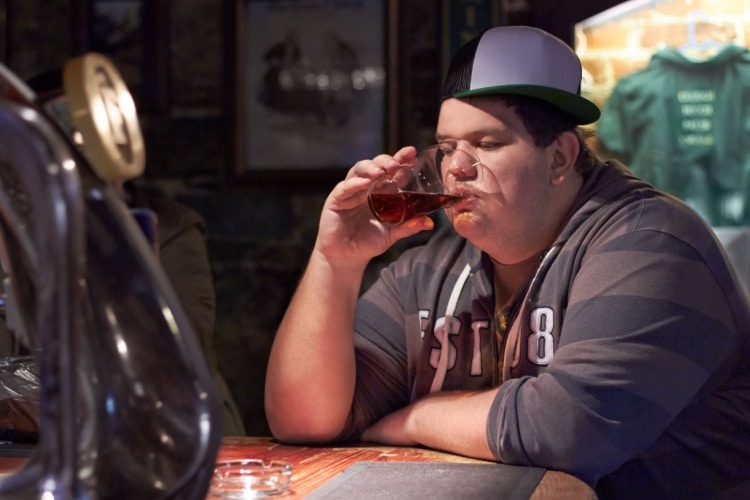On average, it takes 6-7 shots for the average man to get drunk and 4-5 shots for an average woman to get drunk while consuming alcohol.
However, factors like the alcohol concentration, alcohol tolerance, and the size of the shot can influence this range.
This guide explains these factors, provides a deeper insight into alcoholic beverages, and shows the effects of excessive alcohol consumption so you can get a better understanding to remain safe and drink responsibly.

When Does a Person Get Drunk?
Most people begin to exhibit impaired judgment and coordination at a blood alcohol concentration (BAC) of around 0.05% to 0.08%.
This is the legal limit for driving in most countries. At this level, people may feel relaxed, more sociable, and happier, but their reaction time and coordination also start to decline noticeably.
At a BAC of around 0.08% to 0.15%, most people exhibit clear symptoms of intoxication like slurred speech, unsteady gait, blurry vision, slowed reaction times, and impaired memory and judgment. This is considered legally drunk in many jurisdictions.
At a BAC of 0.15% to 0.30%, most people experience severe motor impairment and loss of consciousness, which can be dangerous. This level can occur from drinking a large amount of alcohol very quickly. Blackouts are also more likely at this stage.
A BAC above 0.30% often causes loss of consciousness, dangerously slowed heart rate and breathing, coma, and potential death from alcohol poisoning. Seeking emergency medical help is recommended at this level of extreme intoxication.
So while legal and medical limits provide some guidance, intoxication from alcohol occurs along a spectrum. The exact BAC threshold for feeling drunk or tipsy depends greatly on the individual.
How Does That Apply to Vodka Shots?
The amount of alcohol present in an average vodka shot depends on the size of the shot and the alcohol content of the vodka.
Most bars will pour a standard 1.5-ounce vodka shot, which at 40% alcohol (typical for most vodka), contains about 0.6 ounces of pure alcohol.
So an average single vodka shot contains roughly 0.6 fluid ounces or 18 milliliters of actual alcohol.
For a 130 lb (59 kg) woman with 50% body water, she would have around 30 liters of water content. Consuming one 1.5 oz shot and adding 0.6 oz alcohol gives 0.6 oz / 30 liters = 0.02%.
Therefore, taking one standard vodka shot would cause an approximate 0.02% rise in BAC for an average adult female initially.
Factors Affecting How Fast Someone Can Get Drunk
Here’s why people get drunk at different rates:
Alcohol Concentration

The higher the alcohol concentration (or alcohol proof) in a beverage, the faster it can make someone intoxicated. This is because high-proof alcohol, like 80-proof vodka, contains a larger percentage of pure alcohol compared to lower-proof drinks like beer or wine.
For example, consuming 5 oz of vodka at 40% alcohol would have the same effect as consuming 10 oz of 20% alcohol. The more concentrated ethanol molecules quickly enter the bloodstream from the stomach lining when drinking liquor over 50 proof.
Alcohol Tolerance

People develop alcohol tolerance over years of alcohol consumption. A drinker with high alcohol tolerance may exhibit less impairment in coordination, judgment, and cognition at a BAC level that would severely intoxicate a new drinker.
This is because, over time, the liver adjusts its alcohol metabolization rate, and the brain chemistry adapts to the depressive effects of ethanol from several alcoholic drinks.
Age, gender, and genetics also affect natural alcohol tolerance and the rate of becoming inebriated.
For example, a 50-year-old man who has been a daily drinker for decades can remain functional at a 0.08% BAC, while a young woman with very little past drinking history may show slurred speech by the time she reaches a 0.05% BAC.
Shot Size

Larger shot sizes (1.5 oz or more) contain greater volumes of liquid and higher amounts of alcohol compared to the standard 1 oz shot.
Even though the alcohol concentration may be the same as in a typical shot, consuming a larger volume floods the stomach faster with more ethanol molecules that enter the bloodstream quickly.
The peak blood alcohol concentration is proportional to the total alcohol dosage. Therefore, as shot sizes increase beyond the normal 1 oz serving, drinkers will absorb more alcohol into their blood over a shorter period, leading to faster intoxication effects within the first hour or so of drinking.
Gender

At comparable drinking levels, women tend to reach higher BAC levels than men of the same weight. Physiological and hormonal factors contribute to this phenomenon.
Women have a higher proportion of body fat and lower average body water content compared to men. Ethanol is more soluble in water than fat, so alcohol gets more diluted throughout the body water of men.
Women also have lower levels of alcohol dehydrogenase enzyme in the stomach lining that breaks down ethanol before entering the bloodstream.
Lastly, women’s bodies produce less of this metabolizing enzyme in response to alcohol intake compared to men. All these key differences can contribute to women feeling the effects of drunkenness faster on average at a given number of drinks.
Body Weight

Body weight significantly impacts the rate of intoxication as heavier individuals can spread out and dilute alcohol over a greater total blood volume.
For example, if a 120lb and 200lb person consumed equal amounts of liquor in the same duration, the heavier person would likely have a lower BAC and feel less drunk compared to the lighter one.
Assuming similar body water ratios, the larger body essentially has more liquid to absorb each ounce of ethanol into. Therefore, heavier people require more drinks to reach levels of intoxication on average compared to lighter or petite individuals.
Final Words
In summary, a variety of interplaying factors determine alcohol intoxication levels and drunkenness between different people.
While most adults exhibit legal levels of intoxication at 4-7 drinks, actual drunkenness depends on alcohol concentration, one’s tolerance built over time, shot size, gender, weight, metabolism, and more.
Generally, smaller-bodied individuals who consume higher-proof liquor in larger servings on an empty stomach without prior heavy drinking experience are likely to feel impaired sooner.
On the other hand, those who regularly consume alcohol tend to progress through tipsy stages more gradually.